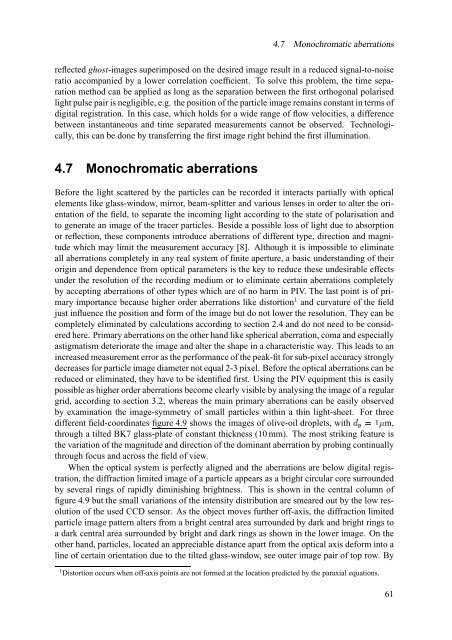The significance of coherent flow structures for the turbulent mixing ...
The significance of coherent flow structures for the turbulent mixing ...
The significance of coherent flow structures for the turbulent mixing ...
You also want an ePaper? Increase the reach of your titles
YUMPU automatically turns print PDFs into web optimized ePapers that Google loves.
4.7 Monochromatic aberrations<br />
reflected ghost-images superimposed on <strong>the</strong> desired image result in a reduced signal-to-noise<br />
ratio accompanied by a lower correlation coefficient. To solve this problem, <strong>the</strong> time separation<br />
method can be applied as long as <strong>the</strong> separation between <strong>the</strong> first orthogonal polarised<br />
light pulse pair is negligible, e.g. <strong>the</strong> position <strong>of</strong> <strong>the</strong> particle image remains constant in terms <strong>of</strong><br />
digital registration. In this case, which holds <strong>for</strong> a wide range <strong>of</strong> <strong>flow</strong> velocities, a difference<br />
between instantaneous and time separated measurements cannot be observed. Technologically,<br />
this can be done by transferring <strong>the</strong> first image right behind <strong>the</strong> first illumination.<br />
4.7 Monochromatic aberrations<br />
Be<strong>for</strong>e <strong>the</strong> light scattered by <strong>the</strong> particles can be recorded it interacts partially with optical<br />
elements like glass-window, mirror, beam-splitter and various lenses in order to alter <strong>the</strong> orientation<br />
<strong>of</strong> <strong>the</strong> field, to separate <strong>the</strong> incoming light according to <strong>the</strong> state <strong>of</strong> polarisation and<br />
to generate an image <strong>of</strong> <strong>the</strong> tracer particles. Beside a possible loss <strong>of</strong> light due to absorption<br />
or reflection, <strong>the</strong>se components introduce aberrations <strong>of</strong> different type, direction and magnitude<br />
which may limit <strong>the</strong> measurement accuracy [8]. Although it is impossible to eliminate<br />
all aberrations completely in any real system <strong>of</strong> finite aperture, a basic understanding <strong>of</strong> <strong>the</strong>ir<br />
origin and dependence from optical parameters is <strong>the</strong> key to reduce <strong>the</strong>se undesirable effects<br />
under <strong>the</strong> resolution <strong>of</strong> <strong>the</strong> recording medium or to eliminate certain aberrations completely<br />
by accepting aberrations <strong>of</strong> o<strong>the</strong>r types which are <strong>of</strong> no harm in PIV. <strong>The</strong> last point is <strong>of</strong> primary<br />
importance because higher order aberrations like distortion 1 and curvature <strong>of</strong> <strong>the</strong> field<br />
just influence <strong>the</strong> position and <strong>for</strong>m <strong>of</strong> <strong>the</strong> image but do not lower <strong>the</strong> resolution. <strong>The</strong>y can be<br />
completely eliminated by calculations according to section 2.4 and do not need to be considered<br />
here. Primary aberrations on <strong>the</strong> o<strong>the</strong>r hand like spherical aberration, coma and especially<br />
astigmatism deteriorate <strong>the</strong> image and alter <strong>the</strong> shape in a characteristic way. This leads to an<br />
increased measurement error as <strong>the</strong> per<strong>for</strong>mance <strong>of</strong> <strong>the</strong> peak-fit <strong>for</strong> sub-pixel accuracy strongly<br />
decreases <strong>for</strong> particle image diameter not equal 2-3 pixel. Be<strong>for</strong>e <strong>the</strong> optical aberrations can be<br />
reduced or eliminated, <strong>the</strong>y have to be identified first. Using <strong>the</strong> PIV equipment this is easily<br />
possible as higher order aberrations become clearly visible by analysing <strong>the</strong> image <strong>of</strong> a regular<br />
grid, according to section 3.2, whereas <strong>the</strong> main primary aberrations can be easily observed<br />
by examination <strong>the</strong> image-symmetry <strong>of</strong> small particles within a thin light-sheet. For<br />
¤¡<br />
three<br />
different field-coordinates figure 4.9 shows <strong>the</strong> images <strong>of</strong> olive-oil Ÿ è<br />
droplets, with m,<br />
through a tilted BK7 glass-plate <strong>of</strong> constant thickness (10 mm). <strong>The</strong> most striking feature is<br />
<strong>the</strong> variation <strong>of</strong> <strong>the</strong> magnitude and direction <strong>of</strong> <strong>the</strong> dominant aberration by probing continually<br />
through focus and across <strong>the</strong> field <strong>of</strong> view.<br />
When <strong>the</strong> optical system is perfectly aligned and <strong>the</strong> aberrations are below digital registration,<br />
<strong>the</strong> diffraction limited image <strong>of</strong> a particle appears as a bright circular core surrounded<br />
by several rings <strong>of</strong> rapidly diminishing brightness. This is shown in <strong>the</strong> central column <strong>of</strong><br />
figure 4.9 but <strong>the</strong> small variations <strong>of</strong> <strong>the</strong> intensity distribution are smeared out by <strong>the</strong> low resolution<br />
<strong>of</strong> <strong>the</strong> used CCD sensor. As <strong>the</strong> object moves fur<strong>the</strong>r <strong>of</strong>f-axis, <strong>the</strong> diffraction limited<br />
particle image pattern alters from a bright central area surrounded by dark and bright rings to<br />
a dark central area surrounded by bright and dark rings as shown in <strong>the</strong> lower image. On <strong>the</strong><br />
o<strong>the</strong>r hand, particles, located an appreciable distance apart from <strong>the</strong> optical axis de<strong>for</strong>m into a<br />
line <strong>of</strong> certain orientation due to <strong>the</strong> tilted glass-window, see outer image pair <strong>of</strong> top row. By<br />
1 Distortion occurs when <strong>of</strong>f-axis points are not <strong>for</strong>med at <strong>the</strong> location predicted by <strong>the</strong> paraxial equations.<br />
61
















